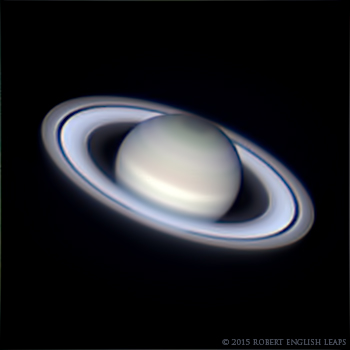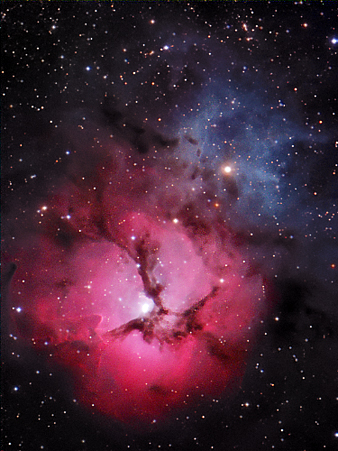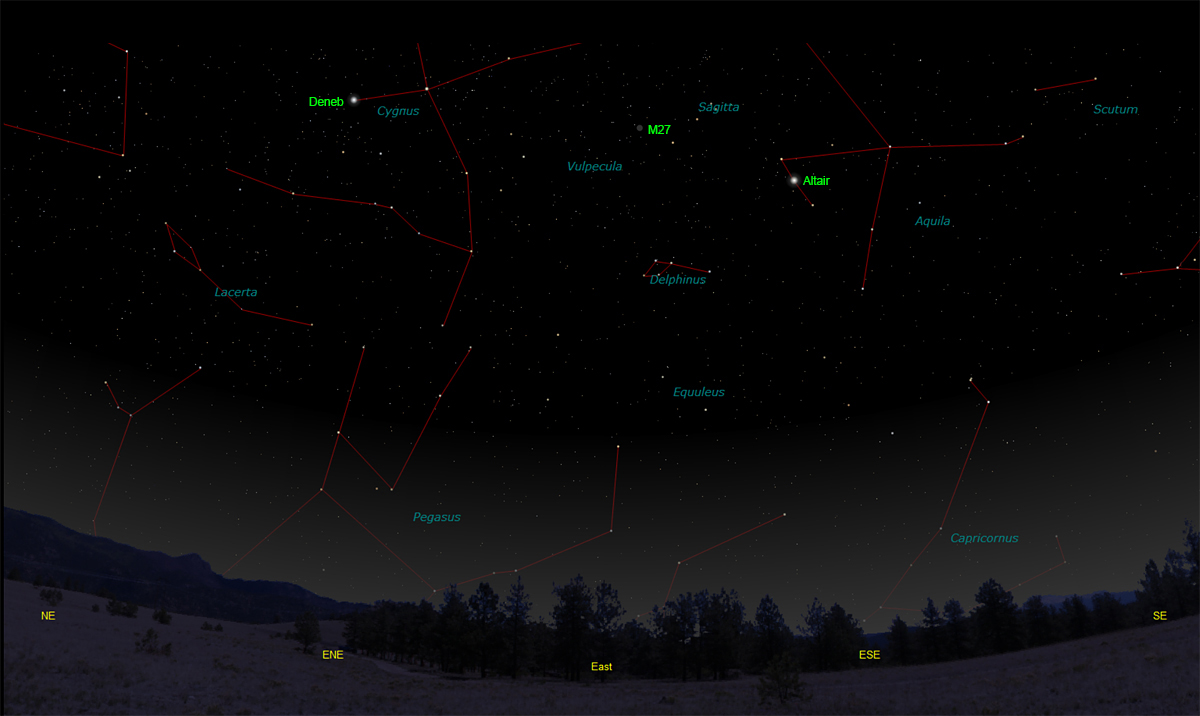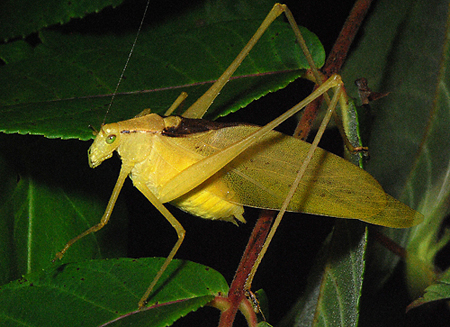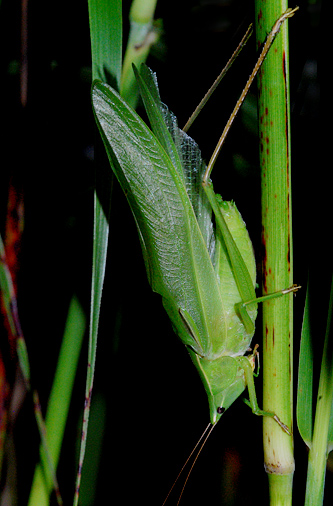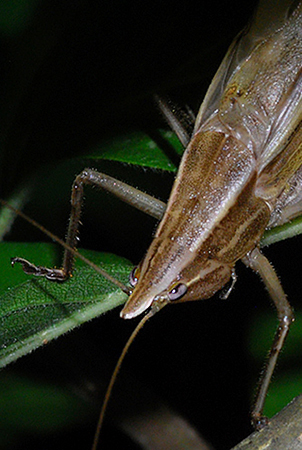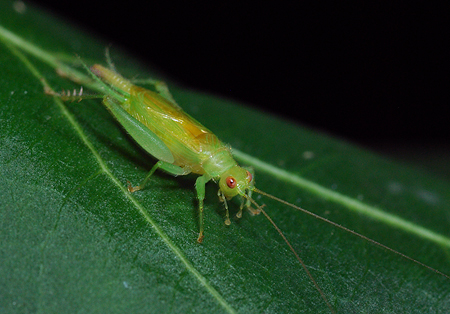The purpose of this feature is to give scout leaders, educators and naturalists an idea of some of the natural events coming up each month. We will try to cover a variety of natural events ranging from sky events to calling periods of amphibians, bird and mammal watching tips, prominent wildflowers and anything else that comes to mind. We will also note prominent constellations appearing over the eastern horizon at mid-evening each month for our area for those who would like to learn the constellations. If you have suggestions for other types of natural information you would like to see added to this calendar, let us know! Note: You can click on the hyperlinks to learn more about some of the featured items. To return to the Calendar, hit the "back" button on your browser, NOT the "back" button on the web page. All charts are available in a "printer friendly" mode, with black stars on a white background. Left clicking on each chart will take you to a printable black and white image. Please note that images on these pages are meant to be displayed at 100%. If your browser zooms into a higher magnification than that, the images may lose quality. Though we link book references to nationwide sources, we encourage you to support your local book store whenever possible.
Notes and Images From June 2017 This Prairie Warbler perched on a branch about 15 feet away when I was surveying birds at the Pelham Range near Anniston, Alabama. Prairie Warblers are just one of many beautiful bird species found primarily in scrub-shrub habitats. Scrub-shrub is characterized by low, multi-stemmed woody vegetation in an early stage of growth. All too often, overgrown fields that are good scrub-shrub habitat are viewed as areas that need to be cleared and developed.
But scrub-shrub habitats are home to some of our prettiest breeding bird species. Blue Grosbeaks, Indigo Buntings, Yellow-breasted Chats, Common Yellowthroats, Blue-winged Warblers and Field Sparrows abound in these areas, and their songs fill the air. This habitat is in decline, and its resident birds are also declining. For some recommendations on what you can do to establish and maintain scrub-shrub habitat, look at the Natural Resources Conservation Service (NRCS) recommendations for managing scrub-shrub habitat here. Sky Events for July 2017: Earth reaches aphelion, its farthest distance from the Sun for the year, on July 3rd around 3:00pm CDT. Evening Sky:
Saturn is in Ophiuchus as the month begins, and will be low in the southeast at twilight. The tilt of the rings is now 26.7 degrees, and the view is spectacular in any size telescope. The planet transits around 11:36am CDT as the month begins. Saturn is pretty low in the south, so the best telescopic views will be close to the the time it transits. The globe of Saturn appears about 18.3 seconds of an arc in diameter. Mercury reaches greatest elongation from the Sun on July 30th. If you have a fairly flat western horizon, you may be able to spot the fleet-footed planet about 8 degrees above the western horizon about 30 minutes after sunset. Morning Sky: Venus rises about two and a half hours before the Sun at the beginning of the month. It's beginning to fade a bit now as the distance from the Earth to Venus increases. All times noted in the Sky Events are for Franklin, Tennessee and are in Central Daylight Time. These times should be pretty close anywhere in the mid-state area. Summer Messier Objects: Looking south on a clear midsummer night yields a treasure trove of Messier clusters and nebulae. The illustration below is made for July 21st at 10:00pm. You will want a clear, moonless evening far from city lights. Saturn will be the brightest object in the southern sky. Once you've found Saturn, look below and to the right of it for Antares, the red giant that marks the heart of Scorpius, the Scorpion. The name Antares means, "rival of Mars." See if you can trace the tail of the scorpion down almost to the horizon, then back up to the two close stars that mark the stinger. These two stars are sometimes called the "cat's eyes." To the left of the cat's eyes look for the stars of Sagittarius. The brighter stars form an asterism known as "the teapot." Above the handle of the teapot you can see the four stars that form the asterism known as "the teaspoon." In a dark sky, the clouds of the Milky Way seem to boil out of the spout of the teapot. This is a beautiful area to scan with binoculars, with many clusters and nebulae. You don't need any equipment at all to see perhaps the most beautiful sight of all - the magnificent summer Milky Way. The sight of the core of our galaxy over the southern horizon, with the spiral arms of our galaxy arcing overhead, is not soon forgotten. You'll need to get far away from city lights. Make a expedition out of it! Compare your view of the Milky Way to the image of the edge-on galaxy NGC 4565 made in May 2016.
Some of my favorite Messier objects reside in this part of the sky. One of the things that inspired me to build a 6 inch reflecting telescope in high school was an illuminated slide of the Eagle Nebula, M16, that was made by the 200" inch telescope on Palomar Mountain. You won't see the bright colors of these nebulae in a small telescope - the eye is very poor at detecting color at these very low light levels. But it's fun to try to spot the faintly glowing clouds. Another favorite is the Swan Nebula, M17. With a telescope you can see a faint "swan" swimming in a pretty star field. You might also see if you can spot the dark lanes in the Trifid Nebula, M20. A nebula filter will help see detail, but will also tend to alter the appearance of the stars in the field. Above the spout of "the teapot" is Messier 8, the Lagoon Nebula. It can be seen with the naked eye on a dark night. If you look at just one southern Messier object this summer, I'd pick the beautiful globular cluster Messier 22. Look for it slightly above and to the left of the star at the top of the teapot's "lid." It's easy to see in binoculars, and in a larger telescope it's just wonderful. It's one of the closest globular clusters, with a distance of just over 10,000 light-years. You may be able to see it with your naked eye on clear dark summer nights. Robert Burnham, in his wonderful "Burnham's Celestial Handbook" said of Messier 22,
Constellations: The views below show the sky looking east at 10:00pm CDT on July 15th. The first chart shows the sky with the constellation outlined and names depicted. Star and planet names are in green. Constellation names are in blue. The second view shows the same scene without labels. Prominent constellations this month in the eastern sky are Cygnus, the Swan, with its bright star Deneb, and Aquila, the Eagle, with its bright star Altair. Below and to the left of Altair is the constellation of Delphinus, the Dolphin, looking like it's leaping over the eastern horizon. Above Delphinus look for the arrow-like form of Sagitta, the Arrow. Between Sagitta and Cygnus lie the faint stars of Vulpecula the Fox. One of the brightest planetary nebula in the sky resides in this little constellation. Messier 27, shown at right, can be seen as a fuzzy patch in binoculars (don't expect the bright colors - just a grayish green spot). Use the easy-to-find stars of nearby Sagitta to locate it, using the finder chart here.On Learning the Constellations: Try learning a few constellations each month, and then following them through the seasons. Once you associate a particular constellation coming over the eastern horizon at a certain time of year, you may start thinking about it like an old friend, looking forward to its arrival each season. The stars in the evening scene above, for instance, will always be in the same place relative to the horizon at the same time and date each July. Of course, the planets do move slowly through the constellations, but with practice you will learn to identify them from their appearance. In particular, learn the brightest stars (like Deneb and Altair in the above scene), for they will guide you to the fainter stars. Once you can locate the more prominent constellations, you can "branch out" to other constellations around them. It may take you a little while to get a sense of scale, to translate what you see on the computer screen or what you see on the page of a book to what you see in the sky. Look for patterns, like the stars that make up the constellation Cygnus.The earth's rotation causes the constellations to appear to move across the sky just as the sun and the moon appear to do. If you go outside earlier than the time shown on the charts, the constellations will be lower to the eastern horizon. If you observe later, they will have climbed higher. As each season progresses, the earth's motion around the sun causes the constellations to appear a little farther towards the west each night for any given time of night. If you want to see where the constellations in the above figures will be on August 15th at 10:00pm CDT, you can stay up till 12:00am CDT on July 15th and get a preview. The westward motion of the constellations is equivalent to two hours per month. Recommended: Sky & Telescope's Pocket Star Atlas is beautiful, compact star atlas. A good book to learn the constellations is Patterns in the Sky, by Hewitt-White. You may also want to check out at H. A. Rey's classic, The Stars, A New Way to See Them. For skywatching tips, an inexpensive good guide is Secrets of Stargazing, by Becky Ramotowski. A good general reference book on astronomy is the Peterson Field Guide, A Field Guide to the Stars and Planets, by Pasachoff. The book retails for around $14.00. The Virtual Moon Atlas is a terrific way to learn the surface features of the Moon. And it's free software. You can download the Virtual Moon Atlas here. Cartes du Ciel (described in the monthly notes above) is a great program for finding your way around the sky. It is also free, and can be downloaded here. Apps: We really love the Sky Safari Pro application described here. For upcoming events, the Sky Week application is quite nice. Both apps are available for both I-phone and Android operating systems. The newest version, Sky Safari 4, is available here.A nother great app is the Photographer's Ephemeris. Great for finding sunrise, moonrise, sunset and moonset times and the precise place on the horizon that the event will occur. Invaluable not only for planning photographs, but also nice to plan an outing to watch the full moon rise. Available for both androids and iOS.
Amphibians:
July’s frogs and toads are much like June’s. Listen for Cope's Gray Treefrogs, Gray Treefrogs, Bird-Voiced Treefrogs, Green Treefrogs and Barking Treefrogs. Eastern Cricket Frogs and Southern Cricket Frogs call a lot during July, and the calls of Bullfrogs and Green Frogs fill the night air. After summer thunderstorms listen for the high, insect-like call of the Eastern Narrowmouth Toad and the strange-sounding Eastern Spadefoot. Be sure to look closely at young toads you encounter. Sometimes we find young Eastern Spadefoots foraging during the day. A young Eastern Spadefoot will have vertical pupils, a tiny spade on its rear feet and will often have some red warts, even when only a fraction of an inch long. A hand lens helps to see these features (or turn your binoculars around and use them for a magnifying glass.) Recommended: The Frogs and Toads of North America, Lang Elliott, Houghton Mifflin Co.
Insects:
For many people, one of the defining sounds of a summer night is the rhythmic chanting of katydids. It doesn't quite feel like summer until you hear them. For me the sound evokes memories of summer vacations when I was a kid. Our family often drove at night along state highways. The interstate system was still yet to come. Our car, like most cars then, did not have air conditioning, so the windows were down. As the highway wound through patches of forest the katydid calls grew louder, enveloped the car, then faded away. My brother and I stretched out on beds our parents made for us on the back seat and floor (no seatbelts then.) We drifted off to sleep to the comforting murmur of our parents' voices and the calls of the katydids, a lullaby.
The eyes of katydids are stunning, with the upper part yellow and the bottom a rich green. Only the males have the purple "cap." Katydids belong to the family Tettigoniidae. The call that is probably best known is that of the Northern True Katydid. It's in the subfamily Pseudophyllinae, and the species name is Pterophylla camellifolia. It ranges over most of the eastern United States. Northern True Katydids typically call from fairly high in the tree canopy, making them difficult to spot. The genus name, Pterophylla, literally means "wing leaf" and they are amazing leaf mimics. Compare the pattern in the katydid's wings in the top image above to the patterns in the leaflet in the lower right hand corner of the image. Northern True Katydids produce sounds by rubbing a sharp "scraper" at the base of one wing against a file-like row of "teeth" at the base of the other wing. Sometimes in large choruses the calls become synchronized. In this recording made at Franklin State Forest in Marion County, a Northern True Katydid close to the microphone begins calling. Note how its call becomes synchronized with the ongoing chorus.
The False Katydids are in the subfamily Phaneropterinae. According to Lang Elliott in his book, The Songs of Insects, there are about sixty-five species of false katydids north of Mexico, represented by 12 genera. One common member of this subfamily is the Oblong-winged Katydid. These katydids have wings that are more elongated than the Northern True Katydid, and the call is a short raspy sound only about a third of a second long.The call sounds a little like a match being struck. In this recording Northern Cricket Frogs are heard calling in the background. The katydid gives only a single note. Oblong-winged Katydids usually are a bright green color, but can also occur in the yellow form shown in the image at left. The yellow form seems to be rarer. Pink forms have also been found.
Since Oblong-winged Katydids like weedy fields and tall vegetation, you
may be more likely to encounter them than some of the other more arboreal
species. So it's a good call to learn.
The calls of coneheads are conspicuous on midsummer evenings. Two common species of coneheads in Tennessee are the Robust Conehead and the Nebraska Conehead. Both species can be either green or a brown in color. Both usually call from weedy vegetation with their head down, as shown in the image at right, ready to drop into the ground cover if alarmed. Coneheads are in the katydid family (Tettigoniidae), which also includes the True Katydids, the Meadow Katydids, the Shieldback Katydids and the False Katydids. The genus is Neoconocephalus. The easiest way to locate coneheads is by listening for their calls. Just drive a few back roads that pass by weedy fields at dusk or later and you should hear them. The Robust Conehead is the larger of the two species and is between two and three inches long. It has a very long, rasping call on one pitch. Like a bad musician, it seems to try to make up in sheer volume what its song lacks in complexity. As you drive by you can sometimes hear the call doppler-shifting downward. The call has a peak frequency of around 8 kHz, and you can listen to one I recorded by clicking here. There are two cuts - the first cut records the sound as you might hear it at a distance, and includes Common True Katydids in the background. The second cut records the sound as you might hear it if one is calling right beside the road.
The name Nebraska Conehead is a little misleading, as the range of this species also includes a wide area of the eastern United States. A little smaller than the Robust Conehead, it measures between 1-3/4 inches to 2-1/4 inches in length. The call of the Nebraska Conehead is also a raspy note on one pitch, but the length of each call lasts only between 1-1/2 to 2 seconds, with a pause of about one second in between calls. Its call peaks around 10 kHz. To listen to a recording of a Nebraska Conehead , click here. Seen close up, the eyes of both species are quite interesting. If you happen across a conehead that is not calling, look carefully at the underside of the cone and observe how it is marked. These markings are a useful way to distinguish between species. See the reference at the bottom of this section for help in identification.
The trigs form another interesting group. These small crickets belong to the subfamily Trigonidiinae (hence the name). They are also known as the sword-tailed crickets. Shown at right is the Columbian Trig. Only about 1/4 of an inch long, these tiny crickets make sounds that many people have heard all their life without knowing the identity of the caller.
A chorus has the rhythmic quality of sleigh bells. Because they tend to blend in with the other sounds of a summer night, you may have to concentrate to pick them out of the many other insect noises on a typical July or August night. I made this recording in our front yard, and since seem to hear them everywhere. Recommended: The Songs of Insects, Lang Elliott and Wil Hershberger, Houghton Mifflin Co. Online: Songs of Insects Lang Elliott Archives (Remember to use the back button on your browser, NOT the back button on the web page!)
Natural Calendar February 2016 Natural Calendar December 2015 Natural Calendar November 2015 Natural Calendar November 2014 Natural Calendar September 2014 Natural Calendar February 2014 Natural Calendar December 2013 Natural Calendar September 2013 Natural Calendar December 2012 Natural Calendar November 2012 Natural Calendar September 2012 Natural Calendar February 2012 Natural Calendar December 2011 Natural Calendar November 2011 Natural Calendar September 2011 Natural Calendar December 2010 Natural Calendar November 2010 Natural Calendar September 2010 Natural Calendar February 2010 Natural Calendar December 2009 Natural Calendar November 2009 Natural Calendar September 2009 Natural Calendar February 2009 Natural Calendar December 2008 Natural Calendar November 2008 Natural Calendar September 2008 Natural Calendar February 2008 Natural Calendar December 2007 Natural Calendar November 2007 Natural Calendar September 2007 Natural Calendar February 2007 Natural Calendar December 2006 Natural Calendar November 2006 Natural Calendar September 2006 Natural Calendar February 2006 Natural Calendar February 2003 Natural Calendar December 2002 Natural Calendar November 2002 Nature Notes Archives: Nature Notes was a page we published in 2001 and 2002 containing our observations about everything from the northern lights display of November 2001 to frog and salamander egg masses. Night scenes prepared with The Sky Professional from Software Bisque All images and recordings © 2017 Leaps.
|
|

